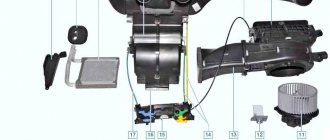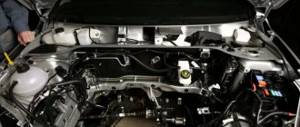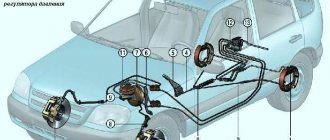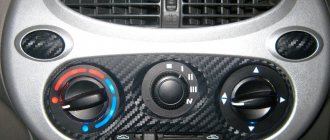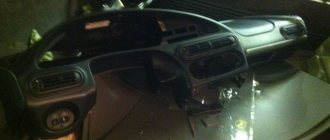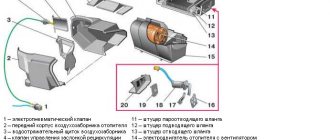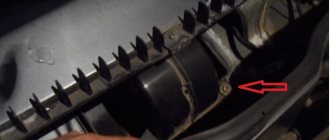What does a car stove consist of and why change the radiator?
In the design of a car heater, the radiator, which plays the role of a heat exchanger, is a key element through which the temperature in the cabin increases (heating). The heater is designed not only to warm up the interior during the cold season, but also to prevent the windows from fogging, thereby impairing visibility and visibility.
The design of a car stove consists of the following elements:
- Plastic case, inside of which the main components are located
- Radiator - also known as a heat exchanger or convector
- Fan powered by an electric motor. Provides targeted air flow through the radiator and through the air ducts into the cabin
- The control valve is an important element through which the coolant supply to the radiator is opened and closed. The coolant is antifreeze, coolant or antifreeze. On Lanos, Sens and Chance, the role of the heater tap is played by a damper, through which the channel for supplying air through the heat exchanger opens and closes
- Pipes and air ducts
In addition, do not forget about the controls for turning on and setting the stove (they are called controls), which on a Lanos car are located in the central part of the dashboard. These are switches through which the fan is turned on, its rotation speed is adjusted, the direction of flow is heated the windshield, side windows or the supply of warm air into the cabin.
The design diagram of a car heater is shown in the photo above. The operating principle of the device is simple, and it is based on the fact that heated antifreeze circulating through the system is supplied to the stove radiator. The plates, honeycombs or lamellas of the radiator heat up, and this heat is used for rational purposes to heat the interior. A fan is used to circulate heat from the heater core into the cabin. You can turn on the stove only after the engine temperature reaches at least 50 degrees.
This is interesting!
Why can't you turn on the heater on a cold engine? This will cause the engine to warm up longer, which will cause increased fuel consumption and other negative consequences. That is why it is necessary to exclude the possibility of turning on the stove until the engine warms up to a minimum temperature of 50-60 degrees.
Interior heating system Chevrolet Lanos Sens and Chance
Lanos cars were produced with two types of heating systems - independent and with air conditioning. On Lanos, the stove is located in the lower part in the center of the console under a plastic casing. It is in the central part of the torpedo that the main component of the stove is located - the heat exchanger. The design diagram of the interior heater of a Chevrolet and Daewoo Lanos car is shown in the photo below.
The diagram shows the following nodes:
- A damper that regulates the distribution of incoming thermal air onto the windows and into the interior
- Distribution top air damper - allows switching between heating and cooling
- Heat exchanger
- A damper through which the air temperature is regulated - cold and hot. This damper replaces the heater valve, which on cars such as Slavuta, VAZ-2101 to VAZ-2109 is used to shut off the coolant supply to the radiator
- Air conditioner radiator
- Fan motor
- The damper through which the air supply into the system is regulated - the suction area. In mode A, air comes from outside, and turning on mode B provides air from the passenger compartment (recirculation mode)
- Lower damper - limiting the flow of cold air into the cabin
- Main heater and air conditioning duct that supplies warm and cold air to the interior
- Branch pipes for blowing windshield and side windows
- Blowing side windows
The operating principle of the Lanos car interior heating system is as follows:
- The air that is directed to the heat exchanger is controlled by damper 4
- Air injection is provided by fan electric motor 6
- The air duct system provides heated air for heating the interior (through the main duct), as well as for heating the windshield and side windows
If the stove does not turn on, then the reason lies in a malfunction of the fan electric motor. If the stove works on Lanos, but at the same time blows cold air, then the causes of the breakdown must be looked for directly in the heat exchanger.
This is interesting!
To extend the life of the heater radiator and engine cooling system, high-quality coolants should be used. In addition to using high-quality coolants, you need to be able to choose them correctly.
Replacing the stove radiator
The heater radiator is the main problem of incorrect operation of the Chevrolet Lanos interior heating system. The easiest way to solve this problem is to replace the radiator. The work is quite complex, labor-intensive and expensive. When replacing a radiator, car service specialists completely disassemble the dashboard in the cabin.
However, the work can be done with your own hands without removing the dashboard. To do this, you will need an inspection hole or overpass and the following tools:
- a set of wrenches and sockets;
- Phillips and slotted screwdrivers;
- stationery knife;
- glue "Moment";
- platypuses.
To replace the radiator you will need a standard set of plumbing tools
The design and fastening of the stove body does not depend on the presence of air conditioning in the car. Therefore, for all Chevrolet Lanos models, the procedure for replacing the heater radiator is the same.
- The car is driven into a viewing hole (the best option).
- The front seats are removed. To do this, 4 bolts are unscrewed under each of them.
- The seat belt sensor is disconnected under the driver's seat.
- Three self-tapping screws are unscrewed and the plastic gearbox cover is removed.
- Two self-tapping screws are unscrewed and the handbrake housing is removed.
To remove the gearbox control rod from the inspection hole, it is necessary to remove the clamp
To remove the manual transmission control mechanism, remove the condensate drain pipe
The gearbox control mechanism can only be removed from the passenger compartment
The sidewalls connecting the center panel casing to the body are removed, and the casing itself is released.
The lower part of the distributor, which directs air flow to the leg area, is secured with three self-tapping screws
To remove the lower part of the stove housing covering the radiator, eight screws are unscrewed
To remove the heater radiator, you need to disconnect the bracket and latch
If the damper does not completely block the flow of cold air, a sealant is glued to it
Installing a new or flushed heater radiator is done in the reverse order.
The radiator can be replaced in another way. To do this, you will need to remove and remove the dashboard from the interior. This operation can be performed on your own in half an hour, without removing the front seats. The dashboard is removed from the passenger compartment along with the stove body, providing access to the elements of the passenger compartment heating system.
Video: replacing the heater radiator with dismantling the dashboard
Choosing a new heater radiator for Chevrolet Lanos
For Chevrolet Lanos, a heater radiator from the Chevrolet Sens model, which has the same dimensions, is suitable. Heat exchangers can be purchased with a strip or plate cooling fin system. In addition, on the market you can find prefabricated strip-plate and tubular-strip brazed aluminum radiators from such manufacturers as NISSENS, AVA, NRF, DAC, GROG, KMC with the number of main tubes from 16 to 22. The cost of products can vary greatly depending on design, workmanship and manufacturer.
Thus, it is quite simple to repair and replace the heater radiator of a Chevrolet Lanos car, consistently following the instructions of professionals. All you need is free time and a standard set of plumbing tools.
What heater regulators are installed on Lanos 1.5 and 1.6 and their purpose
On the central panel in the interior of the Lanos car there are regulators through which the heater is turned on, as well as setting and adjusting the operation. Below is a photo showing the controls.
- The regulator by which damper 4 in the diagram above is activated. Provides opening and closing of the channel for supplying air through or bypassing the radiator
- Turning on the fan and rotation speed of the blades
- Regulator through which air flow distribution is adjusted
- Rear window defroster button
- A slider that opens the air supply from outside or from the passenger compartment to the system
- Button for turning the air conditioner on and off - not present on all models, but only on TOP versions of Lanos
The regulators are connected to the dampers via steel cables. Each regulator is controlled regardless of whether the stove is on or not.
This is interesting!
The radiator is a heat exchanger in which coolant flows through the lamellas. The main malfunction of the device is that the integrity of the lamellas is compromised, and antifreeze leaks occur. In this case, you will need to replace the device with a new one.
How to determine a malfunction of the heater radiator on a Chevrolet, ZAZ and Daewoo Lanos
With the onset of cold weather, it is increasingly necessary to use the interior heater in a Lanos, Sense and Chance car. However, sometimes the owners of these cars are faced with the fact that at one moment the stove does not blow warm air, but, on the contrary, cold air or does not work at all. If the fan motor turns on and the stove blows cold air, then the first thing you should do is check the serviceability of the cold and hot air regulator. The cause of the malfunction may be that the damper is jammed or the steel cable is failing. Make sure that these mechanisms are in working order, after which you can assume that the radiator of the Lanos stove has failed.
To make sure that the heater radiator is faulty on Lanos, Sense and Chance, you need to pay attention to the following factors:
- If the heater heat exchanger on a Lanos is faulty, then the first sign of such a fault is fogging of the windows.
How does this relate to a faulty radiator? If the integrity of the heat exchanger is compromised, coolant will enter the cabin and condense on the glass. - The appearance of a pungent odor in the cabin.
This is the smell of antifreeze that enters the cabin due to damage to the radiator. - Rapid consumption of antifreeze - if you notice that you often have to add coolant, then you should make sure that the heat exchanger of the heater is in good condition
The easiest way to make sure that the integrity of the radiator is compromised is to disassemble and inspect it. If the radiator is damaged, the stove will heat up, but the above factors will be present in the cabin. If the stove does not blow warm air in the Lanos’s cabin, then the reasons for this may be the following factors:
- Thermostat malfunction
- Formation of a plug inside the system or radiator - in this case, the stove will not blow warm air
- Clogging of radiator fin channels
- Various debris such as leaves, fluff, dust getting into the honeycombs of the device
Replacing a heating stove radiator is performed when the device fails. Often the reason for the rapid failure of the heater radiator is its fastening. It is realized through the use of plastic fasteners. Often these fasteners break off due to vibrations and temperature changes, which leads to failure of the entire device. If the device's cells are damaged, it must be replaced. To eliminate the possibility of the brackets breaking off, they should be additionally reinforced with metal latches or brackets. How to strengthen the mounting of the heater radiator on Lanos is shown in the photo.
There is also another way to ensure effective fastening of the stove radiator - use self-tapping screws.
To determine that the standard locking latch has broken off, it is not at all necessary to disassemble the floor of the car just to look. To do this, you need to shake the incoming fittings of the stove from the engine compartment. The presence of play means that the latch has broken off, and disassembly will be required to correct the situation.
This is interesting!
If, when you turn on the stove, you feel a flow of cold air in the cabin, you should resort to sealing the plastic housing.
Why doesn't the stove in Lanos heat up?
A problem that can appear over time in any car is that the “stove” blows cold or slightly warm air. Many reasons are typical for all models, and some are specific to the Lanos stove. Knowing them will help you take the right first steps towards solving your interior heating problem.
One of the main reasons why the stove does not work is a malfunction of the stove radiator itself.
As a rule, factory heater radiators are guaranteed to last up to 5 years (as long as the manufacturer guarantees for new Lanos cars.
Then different turns of events are possible: a leak, a problem with the tubes, loss of heat transfer, etc.
Automotive Blog for Daewoo and Chevrolet car repairs ZAZ-SHOP describes the most popular problems that Daewoo Lanos has and how to solve them.
If you have a question about replacing the heater radiator, we recommend using these recommendations:
The simplest thing that can happen is a fan failure due to a blown fuse, failure of a switch, electric motor, or poor contact in the wiring.
What is needed to replace the heater radiator on Lanos Sense and Chance
It is worth noting that after literally 3-5 years of using a Lanos car, problems arise with the heating system. Most often this happens precisely because of a malfunction of the heater radiator. If the check shows that the heat exchanger of the heater has indeed failed, then it should be replaced. Moreover, this matter cannot be delayed, since inhaling coolant vapors is very dangerous and can cause respiratory poisoning for the driver and passengers.
How can I replace the heater radiator on Lanos? There are two ways to do this. The first involves visiting a service station, and at the same time eliminates the need to delve into the device yourself. This method is good for everyone, except for the cost. For such repairs, the master will ask for at least 2-3 thousand rubles. Additionally, during the repair process, other defects may be discovered, for which you will also have to pay separately. The second method is not so much costly financially as it is physically. Absolutely every owner of these cars can replace the heater radiator on Lanos, Sense and Chance with their own hands. Moreover, there are different ways to do this - with and without dismantling the dashboard.
In order to replace devices on a car, you will need the following tools:
- Set of keys and screwdrivers
- Pliers
- Screwdriver with flexible shaft
- Sealant
The most important thing is that it will take a lot of time. Take one day to remove and replace the heater core on your car yourself. This will save money, which can be spent on purchasing a more reliable heater radiator. Which is better to install a heater radiator on Lanos is described in detail here. Not many people know how to remove the heater radiator on a Chevrolet Lanos. Most people know that this work is painstaking, and therefore they choose the option of replacing it at a car service center. After reading the instructions, you will be able to independently change the heater radiators on Lanos, Chance and Sens, and at the same time save your money.
Failure of fastening
The fifth reason is the most interesting. The design of the heater radiator mounting itself fails. High temperatures, poor quality plastic and heavy loads lead to the fact that the fixing bracket wears out and the radiator gradually breaks off from the air duct. It is not difficult to imagine that cold air then enters the cabin through the cracks. Here, no matter how hard your stove tries, there will be a glacier in the cabin.
At service stations, the cause, on Lanos, is encountered quite often. Therefore, experts advise not to let things get into trouble and to additionally secure the fastening with self-tapping screws or hooks in advance. Please note that everything must be done carefully so as not to break the honeycomb. Then, if the stove on Lanos starts to heat up weakly, you won’t have to worry about the fastening breaking off.
Now you know almost all the probable reasons why it does not heat well, and you understand the intricacies of the heating system of this car as well as an expert. Having checked all the points indicated in the article before the onset of cold weather, you can with almost 100% probability not be afraid that your “swallow” will let you down in winter.
The new stove heats perfectly, but during operation, the fastening often comes off - the bracket that presses the radiator of the interior stove to the air duct. As a result, unheated, cold air begins to flow into the cracks formed, bypassing the radiator. The efficiency of a car's heating system drops from 50% to 90%. There are also possible breakdowns: a clogged heater radiator or the thermostat does not close completely. Any of the cases can be easily diagnosed, for example, if the heater radiator is clogged, then in the engine compartment, the inlet pipe will be hot, and the outlet pipe will be cold or barely warm. If the thermal operating conditions of the engine are violated due to the fault of the thermostat, it is enough to visually analyze the coolant temperature indicator on the instrument panel; after warming up the engine, the needle does not rise to the middle for a long time. If the radiator fastening (bracket) breaks, the easiest way to check is by lifting the heater pipes from the engine compartment. As you might guess, the movement of the pipes means that the heater radiator has fallen. In my case, this is exactly what happened, probably after a “good pit”, I didn’t even realize it at first, I noticed the disorder only with the onset of cold weather. According to the instructions, to eliminate the malfunction you need to remove the dashboard (instrument panel). But fortunately, by nature, I am very lazy and jealous of the money spent on a car during the service interval. The first solution found in the vastness of the Slavic peoples was the replacement or the ability to fix the heater radiator on the Lanos “with some difficult Makar” without disassembling the torpedo. People who described this miracle of action complained about the complex, fragile and damaging assembly process for the stove itself. The plastic of the stove body is broken in places. Somewhere you need to specially saw off, and then during assembly put the sawed-off plastic on the sealant. During reassembly, the air ducts are difficult to put into place, due to the temperature of the plastic...
There must be an easy solution to the problem of attaching the heater radiator. Yes, I have! A very quick and easy way to fix a fallen heater radiator back into place is to insert spacers between the radiator and the heater body. To do this, use a hot knife to cut out a hatch in the lower housing of the radiator air duct measuring 10x10 cm on three sides and bend it to the bottom (heating the plastic at the bend). There is no need to completely cut it out, otherwise after inserting the stove spacers, it will be extremely difficult to insert the cut plastic of the hatch into place. To fix the Lanos stove radiator, you will need: a knife, a gas burner (a lighter with a constant flame will do), sealant, a rubber hose (about 30 cm), and a second glue. The photo made it clearer; I had a mobile phone camera at hand. For easy access to the bottom of the radiator, simply remove the lower air duct directing hot air to the feet by unscrewing 3 screws. When removing the air duct, a bunch of wires hanging on the clips will interfere; you just need to pry one of the right ones with a screwdriver and remove it from the hole. You also need to first unscrew the screws and move back the plastic of the center console, the one between the seats. Move the gearshift lever to the 2nd or 4th gear position, thereby moving the plastic of the center console as far back as possible. Heat the knife on a gas burner and simply insert the tip of the blade into the plastic, slowly cutting it along the contour of the intended hatch. You should not push the knife deep; if you overdo it and insert the blade deep into the air duct housing, you can damage the radiator itself. In the process of cutting out the hatch, you will have to repeat heating the blade several times, since the knife cools down during the cutting process. The very movement of a hot knife in plastic goes like butter. After cutting and bending the hatch, cut off a piece of rubber hose according to measurement, using a knife to make a v-shaped cut on one side that will rest against the edge of the radiator tank. I inserted a short screw or bolt into the inside of the hose to prevent deformation of the hose itself from high temperature. I filled the remaining internal void of the hose and generously coated the section itself at the ends with sealant and inserted the resulting spacer between the air duct body (in which the hatch had already been partially cut out) and the upper part of the stove radiator.
| Raise and secure the heater radiator |
The bottom of the radiator (the place where the pipes exit into the engine compartment) is secured with a pressure plate using a screw. Sometimes, when riding for a long time with a fallen radiator, it breaks out by the roots. I was lucky, the bottom of the radiator was still securely in place. To be safe, I put a couple of sausages of sealant on the dipstick with my finger and at the bottom of the stove (without a hose), there is a gap smaller than a finger. With this “simple Makar”, 4 spacers were installed along the upper perimeter of the radiator. Then I bent the plastic hatch to its rightful place and, using “super” glue, grabbed it at the touch points. When the glue had dried, I coated it with sealant along the entire seam of the hatch and allowed it to dry.
| The stove works again as before |
From the aesthetic side of the matter, all postoperative scars are not visible, since they are covered with a lower air duct casing that directs the flow of hot air to the legs.
It’s +7 degrees outside, I started sweating profusely, before that, at 2 and 4 speeds of the heater motor, it was barely warm in the car. Now you can feel clearly hot coals at the bottom, you have to reduce the heat supply by moving the regulator to the blue zone. Info tags: heater not heating, car heater repair, cold in the car.
Quite often, owners of this model have to find out why the Chevrolet Lanos stove does not heat well. First, let's note: the heater works great, without any complaints from the owner. However, already after the season, problems begin that traditionally come to light with the onset of cold weather.
Putting up with them is dangerous not only from the point of view of getting colds (which, by the way, is also unpleasant and always at the wrong time), but also from the point of view of traffic safety: the windows freeze, there is no visibility, and constantly wiping them off distracts you from the road, which is fraught with in an accident. The heater needs to be dealt with urgently, and I would like it to be done without extra costs. First of all, you need to find out what caused his abnormal behavior.
We will tell you below why the Chevrolet Lanos stove does not heat well and how to eliminate sabotage on its part.
